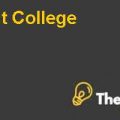Mark Lawrence has been pursuing a vision for more than two years. This pursuit began when he became frustrated in his role as a director of Human Resources at Cutting Edge, a large company manufacturing computers and computer peripherals. At that time the Human Resources Department under his direction provided records and benefits administration to the 60,000 Cutting Edge employees throughout the United States, and 35 separate records and benefits administration centers existed across the country. Employees contacted these records and benefits centers to obtain information about dental plans and stock options, change tax forms and personal information, and process leaves of absence and retirements. The decentralization of these administration centers caused numerous headaches for Mark. He had to deal with employees complaints often since each center interpreted company policies differently – communicating inconsistent and sometimes inaccurate answers to employees. His department also suffered high operating costs since operating 35 separate centers created inefficiency.
His vision was to centralize records and benefits administration by establishing one administration center. These centralized records and benefits administration center would perform two distinct functions: data management and customer service. The data management function would include updating employee records after performance reviews and maintaining the human resource management system. The customer service function would include establishing a call center to answer employee questions concerning records and benefits and to process records and benefits changes over the phone.
One year after proposing his vision to management, Mark received the go-ahead from Cutting Edge corporate headquarters. He prepared his “to do” list – specifying computer and phone systems requirements, installing hardware and software, integrating data from the 35 separate administration centers, standardizing record-keeping and response procedures, and staffing the administration center. Mark delegated systems requirements, installation, and integration jobs to a competent group of technology specialists. He took the responsibility of standardizing procedures and staffing the administration center.
Mark had spent many years in human resources and therefore, he had little problem with standardizing record-keeping and response procedures. He faced trouble in determining the number of representatives needed to staff the center, however. He was particularly worried about staffing the call center since the representatives answering phones interact directly with customers – the 60,000 Cutting Edge employees. The customer service representatives would receive extensive training so that they would know the records and benefits policies backwards and forwards – enabling them to answer questions accurately and process changes efficiently. Over staffing would cause Mark to suffer the high costs of training unneeded representatives and paying the surplus representatives the high salaries that go along with such an intense job. Understaffing would cause Mark to continue to suffer the headaches from customer complaints – something he definitely wanted to avoid.
Individual Case Assignment Cutting Edge Case Solution
The number of customer service representatives Mark needed to hire depended on the number of calls that the records and benefits call center would receive. Mark, therefore, needed to forecast the number of calls that the new centralized center would receive. He approached the forecasting problem by using judgmental forecasting. He studied data from one of the 35 decentralized administration centers and learned that the decentralized center had serviced 15,000 customers and had received 2,000 calls per month. He concluded that since the new centralized center would service four times the number of customers – 60,000 customers – it would receive four times the number of calls – 8,000 calls per month.
Mark slowly checked off the items on his “to do” list, and the centralized records and benefits center opened one year after Mark had received the go-ahead from corporate headquarters.
Now, after operating the new center for 13 weeks, Mark’s call center forecasts are proving to be terribly inaccurate. The number of calls the center receives is roughly three times as large as the 8,000 calls per month that Mark had forecasted. Because of demand overload, the call center is slowly going to hell in a hand-basket. Customers calling the center must wait an average of five minutes before speaking to a representative, and Mark is receiving numerous complaints. At the same time, the customer service representatives are unhappy and on the verge of quitting because of the stress created by the demand overload. Even corporate headquarters has become aware of the staff and service inadequacies, and executives have been breathing down Mark’s neck demanding improvements..................
This is just a sample partial case solution. Please place the order on the website to order your own originally done case solution.










